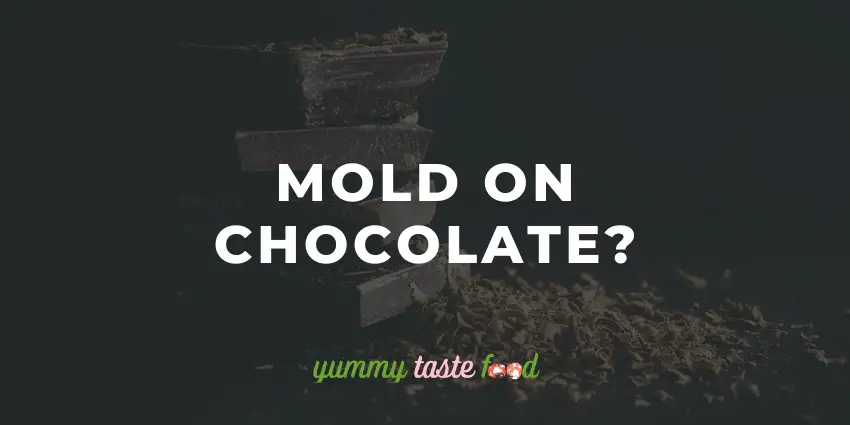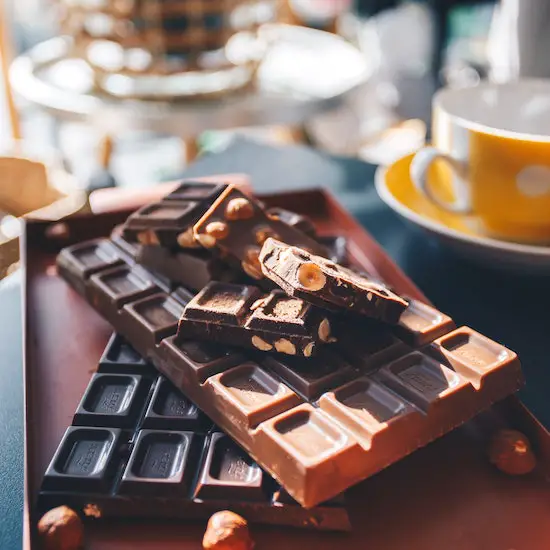
Newsletter Subscribe
Enter your email address below and subscribe to our newsletter

Enter your email address below and subscribe to our newsletter

Is mold on chocolate safe to eat? It is incredibly unlikely that chocolate will mold! The white layer that you may see on your chocolate is known as bloom and is due to the sugar or the fat that is in the chocolate. It is safe to consume and is not a reason to take the chocolate to the trash!
As an avid chocolate eater myself, I have experienced the rollercoaster of discovering a bar of your favorite chocolate, maybe long forgotten, but then discovering it doesn’t quite look as it seems… I have conducted some research into this topic to uncover the answers for you all and to put you at ease.
Most of us would toss any questionable-looking chocolate in the garbage and not risk it since we are constantly reminded and warned of the negative health impacts of mold. Chocolate, however, may not always actually be moldy when we think it is.
The bloom on chocolate might appear chalky and could alter its flavor, but it’s not harmful to your health, and you can continue to eat the chocolate, believe it or not!
If you’re still hesitant to eat the white coated chocolate, continue reading to learn the truths I have uncovered!

It is extremely difficult for chocolate to create mold since the bars we purchase from stores don’t have enough moisture to allow mold development.
The chocolate we consume is dry and fairly moisture-free, the complete opposite environment to that which bacteria and mold require to flourish.
But, sometimes you may notice a chalky white layer over chocolate perhaps if it has been left on the counter too long. Even though this might look like mold, it’s quite different and is referred to as bloom.
Bloom happens after the chocolate has been exposed to different temperatures or moisture from the outside and this is the reason the bloom is only affecting the exterior of the chocolate.
The flowering is caused by the sugar or fats that crystalize in chocolate causing the off-white chalk coating, or dots, that chocolate forms.
One of the times that you may notice the presence of mold in chocolate is when they create chocolate at home using wet ingredients. It could be the case with truffles, chocolate chips, made at home, or other chocolate delights that have a different texture from chocolate bars.
This won’t happen in chocolate bars that are purchased from stores because they are generally extremely dry and devoid of moisture.
The reason you think your chocolate is turning moldy due to the bloom is a frequent occurrence when chocolate is exposed to moisture from the outside or changes in temperature.
There are two kinds of blooms, meaning there are two reasons why your chocolate might form a white layer.
One is the bloom of sugar and the second is a fat-based bloom. Here’s a little bit about each to ease your mind that it’s not mold!
Sugar bloom occurs when chocolate comes in contact with moisture.
The crystals of sugar on the bar’s surface disintegrate and then appear as white chalky residue on the chocolate’s surface.
Fat bloom occurs when chocolate isn’t tempered appropriately, or if stored in conditions in which temperatures change quite dramatically.
The fat-induced bloom looks very much like sugar blooms, but has some gray tinge and is extremely dusty.
The majority of fats work well at various temperatures, however, cocoa butter is firm at temperatures in the room. So when exposed to higher temperatures it will melt, and return to its unsuitable state, only to create the white layer over the top.
Although it’s uncommon, however, there is a possibility that chocolate could develop mold.
Most of the time, the white coating you see on chocolate is made up of the sugar bloom, or fat bloom but there are a few special situations where chocolate may produce mold.
One reason chocolate can develop mold is if the cacao beans used to create the chocolate became damp before processing.
Cocoa, the primary ingredient in chocolate, is harvested and then processed to create chocolate.
Most well-known chocolate companies pay a premium cost for high-quality cocoa beans, however, some don’t. If companies have paid low cost for their ingredients, there is a chance that they could not have been stored or treated as well as they would have needed to be to create a bar of high-quality chocolate.
This will likely make your chocolate have an off flavor that you will be able to detect immediately If you let it sit, your chocolate may mold over time, though this is not likely.
In other, less likely, cases mold can be caused by poor packaging or pathogens that chocolate was exposed to during the process of packaging.
Other ingredients that are added to chocolate, for example, nuts or fruit, could be another reason why mold may exist.
If you’re unsure about the smell or taste of a chocolate bar, it is safer to discard it and purchase a new stash!
Green and white mold are two of the most commonly seen shades of mold on food items in your house.
This doesn’t mean white mold and green mold are necessarily the same mold types, but the method by which the color develops is the same.
The main distinction between white and green mold is the type of surface they prefer to grow on, with the green mold preferring food sources and the white mold preferring to thrive on wood or plant-based surfaces.
The green mold is the one that you will most often encounter on fruit along with starch-rich food items, like bread. Like some other molds, it requires moisture to flourish and grow. That is why fruit is a wonderful habitat for it.
If there were to be mold on chocolate, regardless of whether it’s from moldy cocoa beans or poor packaging, it would be a green mold.
Do not consume any chocolate that has visible green mold to protect yourself.
Chocolate that has mold would look like the kind you imagine it to be. There would appear to be signs of mold growth on the chocolate’s surface. It is likely to be green in color – not the delicious sight of the irresistible chocolates we all love.
Bloom is frequently mistaken for white mold with its chalky white appearance on chocolate when exposed to various temperatures or external moisture, but the bloom is harmless to health.
It is sometimes difficult to distinguish the two.
The chocolate that has been contaminated by mold can also give off an unpleasant smell or taste so that it will be very undesirable and you won’t want to eat it.
While mold and bloom appear similar, there’s a distinction between them. And if it appears white and fuzzy, and is rising above and off the chocolate’s surface It is mold.
If it’s only a chalky layer that is on the surface of the chocolate, then it’s probably simply blooming.
It’s not easy to determine if chocolate is deteriorating. There are a few indicators you should look out for to tell whether your chocolate is safe to consume or not.
There are many things you should think about whether or not to consume the chocolate you discovered in the trash or if it’s better to discard it and purchase a new bar!
Common sugar bloom distinctions are:
Your chocolate will begin to develop a white chalky appearance and may cause the chocolate to have a grainy texture. This doesn’t provide the most pleasurable eating experience; however, it’s completely fine and safe to consume.
Similar to sugar blooms and fat blooms, fat blooms can create a white-gray film to appear on the surface of the chocolate. These cocoa butter oils are separated and are rising to the top, causing an appearance change.
Like with sugar blooms, fat blooms are harmless and actually will not significantly alter the flavor or texture.
Chocolate is one of the food items that absorb the smell of any food that is near it. This can be unsettling when the chocolate is kept in a room with strong-smelling food items!
If you smell an odor coming from the chocolate, but it isn’t wholly repugnant, and you don’t see any other evidence of spoilage, it is probably completely safe to eat.
If you do observe that your chocolate gives an unusual smell and it’s not next to other foods that have strong odors this could indicate that it has passed its best-by date and must throw it away.
Always be sure to verify the expiration date of the chocolate you want to consume.
The majority of the time, it’s perfectly permissible to eat chocolate after the date of best-by since it is merely a sign that the chocolate’s quality isn’t as excellent as it ought to be but all in all, this will not be a big deal.
If there’s an expiry date for the chocolate, be aware of it mainly when it contains additional ingredients such as fruits, caramel, or nuts.
It is recommended to look for signs of spoilage when the chocolate you’re planning to consume has reached the expiration date.
While this isn’t the only method to determine the difference between food that has been spoilt and food that is fine, you will be able to decide immediately if chocolate is bad just by the taste alone.
It’s improbable and rare for chocolate to spoil; however, if it has become rotten, you will immediately taste an unpleasant or rancid flavor.
Sometimes, it could be an overwhelming cocoa flavor, a sour taste other unusual flavors you just don’t recognize.
The white layer you observe on the surface of your chocolate is likely a sugar bloom or fat bloom. This is entirely acceptable to eat, and you don’t need to remove it.
If the chalky white coating irritates you, you can cool the chocolate and put it into molds, and once set it will no longer be there.
This will take off the white film and provide normal-looking chocolate again. However, be aware of the fact that tempering your chocolate more than one time could alter the flavor quality.
It’s never recommended to try and consume food that has already turned moldy. We will always recommend throwing away food items that have begun to mold.
Some people like scraping off the mold from chocolate and then eating the rest. If the mold isn’t spreading to a large extent and you’re in a position to remove any mold there’s likely to be little chance of foodborne illness.
What number of chocolate bars have you tossed in the garbage because of the white coating on top? You may be disappointed to discover that you didn’t have to throw them out all the time and that the chocolate was delicious to consume!
It’s always best to take your time and avoid eating food you’re not sure about if you spot the shiny coating of velvety chocolate, you’ll know straight away that it’s okay to gulp down.
The chocolate’s bloom is not likely to make you sick or cause harm to your health. But, you may observe a slight difference with the consistency of your chocolate becoming a little more coarse than usual.
The chocolate may also lose some of its taste due to blooms but this is not the end of the world if you really need a chocolate fix!
If you don’t want to consume chocolate with blooms, it is possible to use it in recipes calling for chocolate. Once melting the chocolate, the bloom fades away, and the chocolate returns to normal!
We’ve covered the steps required to suss out if it really is mold on your chocolate and what to do if mold appears in chocolate, so now we’ll look at a couple of other concerns!
The question of whether or not to store your chocolate in the fridge is a highly debated issue in a lot of households! There isn’t an apparent response to this. If your house is steadily at a cool temperature, there’s no reason to keep chocolate in the refrigerator.
When your home’s temperature is often fluctuating, it is a more beneficial option to store chocolate in the refrigerator. It is important to remember that chocolate kept in the fridge may still develop bloom, though.
Completely! You could remove the chalky layer with a knife if the texture is undesirable for you. Or, as mentioned above, you could melt the chocolate for baking recipes or re-set it in molds. This will reintegrate the chocolate’s fats and remove the white particles on the outside.